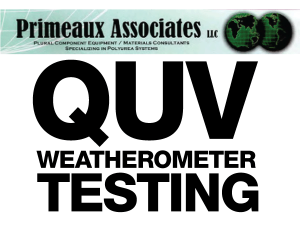QUV Weatherometer Testing: (ASTM G 53)

QUV Weatherometer accelerated testing (ASTM G 53) has been used as a tool to evaluate the performance of polyurea spray elastomer systems. By using this technique, one can observe the physical affects of simulated sunlight on the surface properties of the exposed elastomer as well as physical property retention.
AROMATIC SYSTEMS: Due to the nature / chemical composition of aromatic polyurea spray elastomer systems, there will be a color change noted when exposed to direct sunlight. The level and type of pigmentation used in the formulated systems will affect the degree of color change noted. Formulation steps can be taken to minimize this color fading, but it will still occur over time in exposure to sunlight.
The following basic results have been noted:
Hours of Exposure: 250, 500, 1000, 1500, 2000 and 3000 (4 hours light/4 hours dark cycle)
Light Source: UVB-313 bulb
Surface Color Change: Slight yellowing, varies due to exposure
Surface Chalking: None
Surface Cracking: None
Gloss Retention: varies for total exposure
Physical property retention: > 90% of original (after 3000 hours)
Note that while there is a color change on the surface of the elastomer system, there is no significant breakdown of the elastomer noted as evidenced by the retention of elastomeric physical properties.
ALIPHATIC SYSTEMS: Properly formulated aliphatic based, not modified, polyurea elastomer systems show excellent results when exposed to the accelerated QUV Weatherometer testing. This is noted by excellent color, gloss and elastomer physical property retention.
The following basic results can be noted:
Hours of Exposure: 3000 (4 hours light/4 hours dark cycle)
Light Source: UVB-313 bulb
Surface Color Change: None
Surface Chalking: None
Surface Cracking: None
Gloss Retention: > 90%
Based on earlier work with the aliphatic polyurea spray elastomer systems of this type, it is expected that 5000 hours of exposure can be exceeded with similar results.







